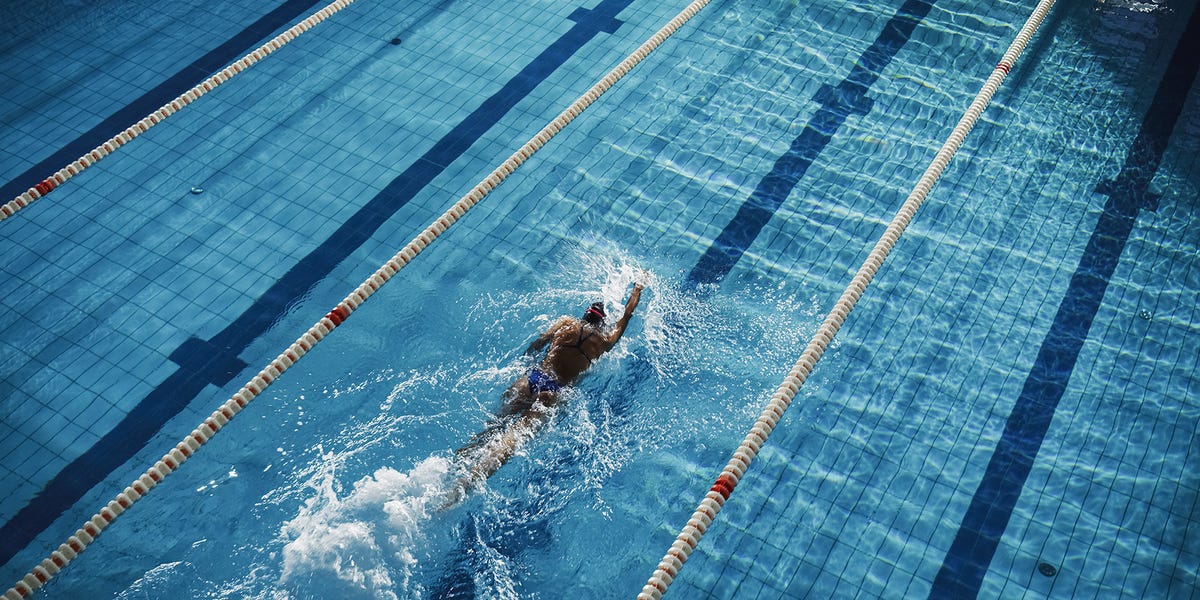Move over, cycling and running. There’s another way to get your cardio in: swimming. We get it—getting yourself to a pool and strapping on your goggles might feel like a lot of extra effort—but swimming is definitely a worthwhile workout, especially if you’re looking to mix up your routine. By incorporating a variety of swim strokes, a single workout can target *all* your major muscle groups. (Can cycling and running say that?) In fact, pulling yourself through the water builds strength in your arms, legs, and core.
Another major perk: the calories burned swimming add up quickly.
Swimming is “one of the best cardiovascular workouts anyone of any age can do,” says Kris Gagne, a registered and certified swim coach with USA Swimming and the American Swimming Coaches Association. As you continually move your bod from one end of the pool to the other, “the aerobic work helps strengthen the heart muscle itself, making it more efficient at pumping blood throughout your body,” he says.
Meet the expert: Kris Gagne is a registered and certified swim coach with USA Swimming and the American Swimming Coaches Association.
Beyond the calories you’ll be burning, swimming can make a substantial difference in lowering your risk of coronary heart disease, and even support your mental health, according to research in Oxidative Medicine and Cellular Longevity and Frontiers in Psychology. Another bonus: swimming puts virtually no pressure on your bones and joints, which makes it a low-impact form of exercise.
Of course, the benefits you reap from taking your workouts into the water depends on a few key factors. Here’s what to know about how many calories you can burn swimming—and how to torch as many as possible.
How many calories do you burn swimming?
While swimming is generally a pretty darn impressive calorie-burner, just how many you burn depends on several factors, including your weight, intensity, and which stroke you’re doing.
Generally, Harvard Medical School estimates that in 30 minutes of recreational swimming:
- A 125-pound woman will burn about 180 calories
- A 155-pound woman will burn about 216 calories
- A 185-pound woman will burn about 252 calories
However, if you turn up the heat and vigorously swim laps for 30 minutes, your calorie-burn increases. In this case,
- A 125-pound woman will burn about 300 calories
- A 155-pound woman will burn about 360 calories
- A 185-pound woman will burn about 420 calories
If you want to get an even closer estimate of how many calories you’ll burn during your swim session, an MD created this trusty swimming calorie calculator, which can help you get a ballpark. Input your body weight, preferred swim stroke, and the duration of your workout—with personalized results, you’ll be able to compare how many calories you’ll burn when you’re swimming breaststroke, backstroke, butterfly and more. Whether you’re easing into your swim with a leisurely breaststroke, or going all out with a butterfly or crawl, make no mistake: You’ll get a great full body workout regardless of the stroke you choose.
What affects how many calories you burn while swimming?
There are four main factors that influence the calorie-torching power of your pool workout. They are:
- Swimming stroke: Certain strokes are more technical and expend more energy than others, explains Gagne. Since butterfly involves sweeping both arms up out of the water and straight out in front of you at once all while performing a difficult dolphin kick, it’s much more exhausting than breaststroke, in which you can more leisurely frog kick and pull yourself through the water.
- Body weight: The more weight you have, the more effort you’ll have to expend to move yourself through the water, leading to a higher calorie burn. Plus, a larger body size means you have more surface area in the water, which then means you’ll face greater resistance and need to work harder to continue moving.
- Intensity: With each lap, you’re challenging your heart and lungs to pump oxygen-containing blood throughout your system, per a 2024 study in Physiological Reports. As your swim workout increases in intensity, your body expends even more energy to do this. So, the harder you swim, the more calories you burn, says Gagne.
- Duration: The amount of time you’re spending in the water certainly matters, Gagne says. Naturally, the longer you’re swimming, the greater the calorie burn, simply because you’re spending more time exerting yourself.
How To Burn More Calories Swimming
If you’re looking to up the ante of a swim, the good news is: you have options. You don’t have to do lap after lap of butterfly (it’s hard!) to torch more calories while swimming. Incorporate one of these three strategies the next time you dive in.
1. Create more resistance.
“The more resistance you have in the water—whether using equipment or your own body—the more calories you’ll burn,” says Gagne. Steal a move from swimming pros and layer a slightly-loose swimsuit over your go-to Speedo (this is called a drag suit) or try out gear like hand paddles or fins.
2. Incorporate intervals.
You know upping your swimming speed means more calories burned, but you don’t have to go full-Katie Ledecky for 30 minutes straight to see big benefits.
Whether you’re crunched for time or building up your stamina, Gagne suggests using interval training. For instance, swim as hard as you can for 30 seconds, then swim at a leisurely pace for 60 seconds, then repeat.
Just like HIIT on the tread, breaking up your pool workout this way allows you to maximize your effort and time while improving your performance and burning calories.
3. Swim IMs.
In an IM (a.k.a. individual medley), you swim each of the four primary strokes back-to-back to switch up the stimulus on your bod and, ultimately, turn up your burn, says Gagne.
Try this: Swim one lap of butterfly, then a lap of backstroke, then a lap of breaststroke, and finally a lap of freestyle. Use the strokes that feel easiest to you as recovery, or do a few laps of leisurely breaststroke or backstroke after your IM to recover before repeating.
Do you burn more calories swimming than you do running or biking?
Fun fact for all of you swim skeptics out there: You can totally burn as many (if not more) calories in the pool than you can on the bike or tread, as long as you put in the effort.
If you run at a 10-minute mile pace, for example, you burn about as many calories in 30 minutes on the tread or pavement as you would in the pool, per Harvard Medical School. However, if your pace lands closer to 11-plus minutes per mile, you’ll burn more calories in the pool.
It’s a similar story when it comes to swimming and bicycling. Spin those wheels at a moderate pace for 30 minutes on the stationary bike, and a 155-pound woman burns about 252 calories. (That’s almost 100 fewer calories than 30 minutes of vigorous laps.) Kick up the spinning intensity to an all-out effort, though, and that same woman burns about 278 calories in 30 minutes.
Andi Breitowich is a Chicago-based writer and graduate student at Northwestern Medill. She’s a mass consumer of social media and cares about women’s rights, holistic wellness, and non-stigmatizing reproductive care. As a former collegiate pole vaulter, she has a love for all things fitness and is currently obsessed with Peloton Tread workouts and hot yoga.
Caroline is a lifestyle writer based in New York who covers beauty, wellness and culture. She regularly writes for USA TODAY’s Health and Wellness section, and contributed to a Pulitzer Prize-winning investigation at The Washington Post.
Read the full article here




